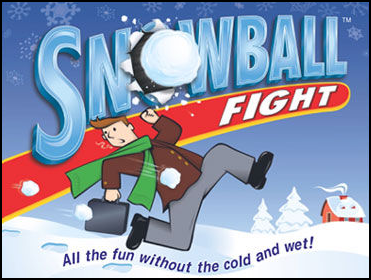 |
| Snowball Fight Card Game - A snowball fight without the cold or snow? |
All this winter I've listened to my family describe the heavy snows, the icy roads, the blowing winds and the frigid temperatures. Still a Midwesterner at heart, I miss the cold and snow and have MANY wonderful memories of building snowmen, snow furniture, snow forts, and having snowball fights. Stuck in this cool, but nowhere near frigid weather of the southwest, I have to find my snow fun elsewhere. Enter Snowball Fight Card Game, a card game that lets you lob dipsy doodles, rapid fire, and even sneak attack snowballs at your opponents. Without the frostbite or soaked mittens. (It's still not the same thing, but it runs a close second).
This is a card game that consists of 22 different cards (170 total). There are 10 different offensive snowball attack cards and 7 defensive cards (there are multiple cards of each particular card). Each card is assigned a score. The overall goal is to keep your score as low as possible.
Taking turns, one player will choose one opponent and play an offensive snowball card against them. Then they will throw the die and that number will be the amount of points that will be added to the score of the person attacked. However, the player who is attacked is allowed to play a card in their defense, if they have one, which may reduce the amount of points held against them. A defending card may even give the attacked a chance to throw the die and force points on the attacker. The different cards that are played are worth different points and unless you play this game A LOT, you will probably have to play with the score card by your side. Here is a picture of it.
 |
| LEFT: Offensive shots. RIGHT: Defensive shots. |
Object:
Be the last person to accumulate 30 points.
Set up:
Shuffle the cards. Deal six cards to each player. Put the remainder of the cards in a face-down pile on the table.
Play:
The first player announces the person they want to attack, they plays an offensive card against them, and then they throw the die to see if their snowball hits the defending player. Now these three things must happen in this order (and I quote):
- Reduce the attack roll(s) as instructed by the defending player's defensive card. Example: Subtract 2 from Attack Roll reduces die roll of a 5 to a 3.
- If the reduced die roll still falls into the offensive card's hit range (indicated on each card at the bottom), the defending player has been hit with a snowball! Add the points noted on the card to the defender's total score. If it does not fall into this range, it is a miss and no one takes points.
- If Bad Aim, Powder Ball, or Catch has been played by the defending player, that player just happened to have a snowball in their hand and attacks you back. When the defender plays this Return Attack card, he is allowed to roll the die. If it comes up five or six, the attacker now becomes the victim and must take 2 points. The attacker is not allowed to defend himself (unlike a REAL snowball fight).
It seems a little complicated, but it is just a matter of playing a snowball attack card and throwing the die, then playing a defensive card, and then using the number on the die with the number on the card to determine the score.
Try this:
Work on following directions, keeping score, strategy, manual dexterity, problem solving, shuffling/dealing/holding/fanning cards, process skills, executive function skills, socialization skills, play and leisure exploration and participation
In the box: 1 6-sided die, 170 cards, card description sheet

No comments:
Post a Comment
Thank you for taking the time to comment.